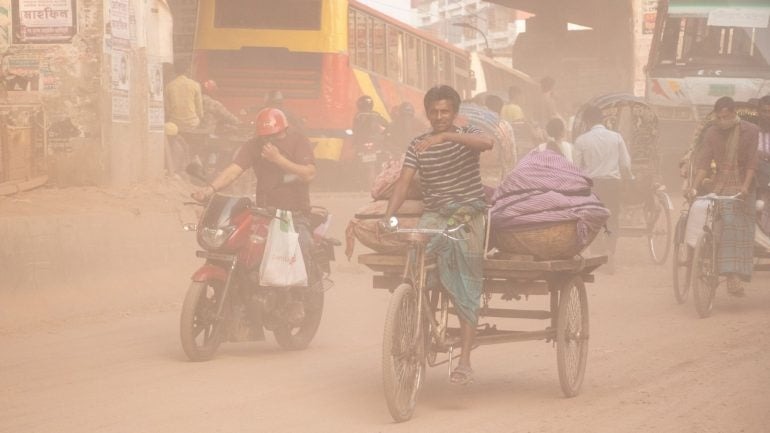Report
World Air Quality Report: what are the health impacts and where is it worst?
Highly industrialised countries have the worst air quality, which causes pulmonary diseases and burdened healthcare. Alex Blair reports.

Dhaka, Bangladesh has the second-worst rates of air pollution in South Asia. Credit: NurPhoto / Getty Images
Just seven countries had clean air quality in 2023, a new report has found, with analysts pointing to the clear correlation between fine-particle air pollution and pulmonary diseases in local residents.
IQAir’s World Air Quality Report named Australia, Estonia, Finland, Grenada, Iceland, Mauritius and New Zealand as the only countries that met the World Health Organisation (WHO) guidelines for PM2.5, one of the most prevalent forms of air pollution.
Just 9% of global cities met the guidelines, based on data from 30,000 air quality monitoring stations across 7,812 locations in 134 countries, territories and regions.
How does air pollution impact lung health?
Multiple research studies have illustrated the association between exposure to PM2.5 air pollution and increased risk of hospital admission for major lung diseases such as asthma, chronic obstructive pulmonary disease (COPD) and lung cancer.
As the third leading cause of death worldwide, causing more than three million fatalities each year, COPD is a particular concern among healthcare experts and planners.
However, there is now a better understanding of the damage inflicted by air pollutants typically emitted in industrialised urban areas, according to Filippos Maniatis, healthcare analyst at GlobalData.
“It is now known that air pollutants including ozone, particulate matters and sulphur dioxide can significantly impact the normal lung function,” Maniatis tells us. “Research now recognises air pollution as a cause of asthma development, through triggering inflammatory responses, and intensifying the symptoms in individuals with pre-existing asthma.”
Home to the ten most polluted cities in the world, the Central and South Asia region suffers from some of the highest pulmonary disease rates in the world.
COPD prevalence in South Asia is highest in north India (19.4%) and Bangladesh (13.5%), where coal mining remains a major economy.
“It is important to also highlight the influence of air pollution on the development and progression of lung cancer, with studies identifying somatic genomic mutations associated with household air pollution and specifically coal combustion,” Maniatis adds.
How does industrialisation drive air pollution?
Sources of PM2.5 pollution vary widely, from the brick kilns in Bangladesh to the copper mines of Chile. The overwhelming polluting factor, however, is the burning of fossil fuels such as coal, oil and gas.
Air pollutants, such as biomass fuels, have also been associated with the development of COPD, especially in developing countries that use biomass for cooking and heating without proper ventilation, increasing the levels of indoor air pollution and COPD risk.
Among the seven countries that IQAir’s report said met the WHO’s air pollution requirements were Iceland, where more than 95% of generation capacity is geothermal or hydroelectric, and New Zealand, where 80% of energy generation is renewable.
“Low levels of industrialisation” are the primary cause of purer air, but environmental events are also a key factor, says David Kurtz, head of analysis for construction at GlobalData.
Australia generally has clean air quality, with the capital Canberra ranked as the third cleanest city, with 3.8 µg/m3 of PM2.5 rate – compared to 92.5 µg/m3 of PM2.5 in New Delhi, India.
The most noticeable dips have been driven by bushfires, but “Australia hasn’t had any serious bushfires since 2019/2020”, Kurtz says.
The acute effects of the smoke from the 2019/2020 wildfire period in Australia were responsible for 417 excess deaths and 1,124 hospitalisations for cardiovascular problems, statistical modelling shows.
The ultimate burden of poor air quality falls on healthcare systems worldwide.
“In the US, the economic burden of lung diseases is estimated at $129bn, with $106bn being attributed to the direct costs of managing these conditions” Maniatis concludes. “These staggering figures underscore the importance of improving air quality, to control the prevalence of respiratory diseases and minimise their healthcare burden.”